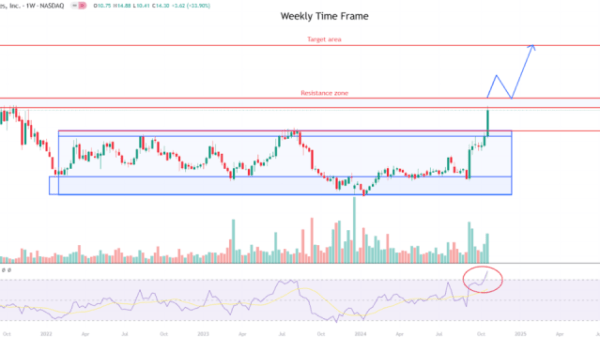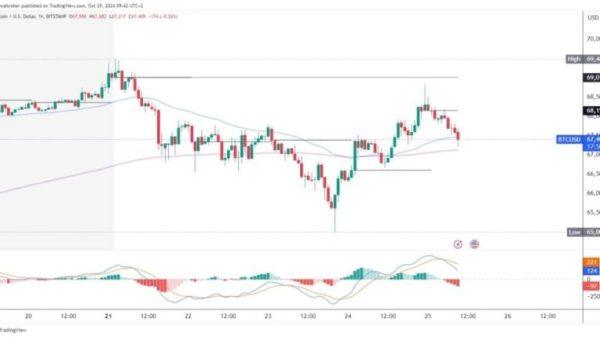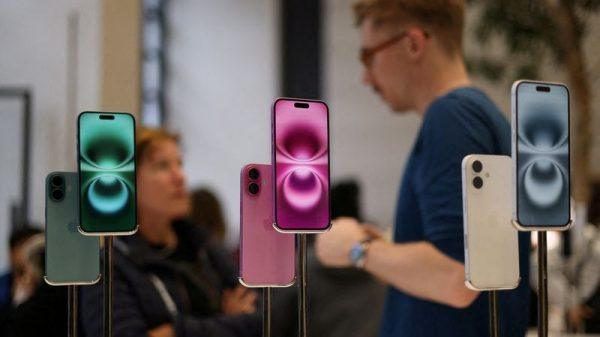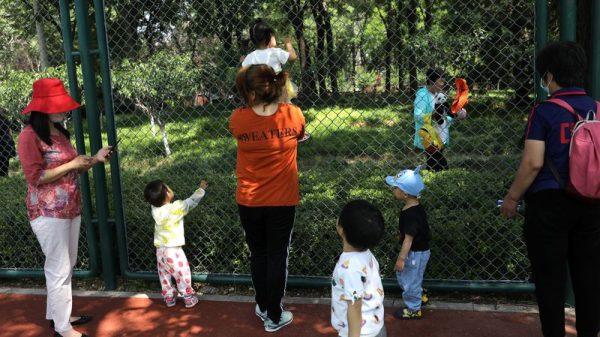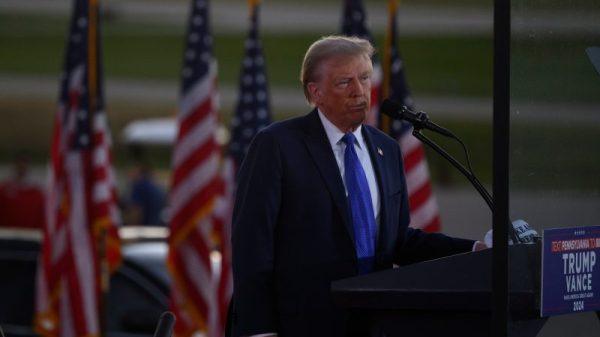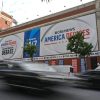TomTom N.V. (TOM2.AS) reported a 2% year-over-year decline in group revenue for the third quarter of 2024, totaling €141 million. The company faced challenges in its automotive segment due to a global industry slowdown, while its Enterprise business showed growth.
Key Takeaways:
Group revenue declined 2% year-over-year to €141 million
Automotive segment operational revenue dropped from €85 million to €69 million
Enterprise business grew 13% to €42 million
Free cash flow improved to €50 million, up from €30 million year-over-year
Net cash position of €270 million at the end of Q3
Company Outlook
Expects positive full-year free cash flow
Anticipates Location Technology revenue to align with lower boundary of guidance
Projects revenue growth in late 2026 and 2027
Targets navigation take rates to rise towards 50% by 2025
Bearish Highlights
Automotive segment faced challenges due to global industry slowdown
Continued pressure expected in Q4, but at a reduced rate
Uncertain order intake situation with OEMs adopting a wait-and-see approach
Bullish Highlights
Enterprise business grew by 13% to €42 million
Free cash flow improved to €50 million
Positive win rates trending, confidence in gaining market share
Ongoing shift towards electric vehicles (EVs)
Misses
19% decline in automotive operational revenue for Q3
Softening end market and destocking effects, particularly in the U.S.
Q&A Highlights
Competitive advantage due to deeper integration and safety features
Navigation take rates trending upward, target of 50% by 2025
Trade receivables dropped to approximately €60 million in Q3
TomTom’s third quarter results for 2024 reflect a mixed performance across its business segments. The company reported a 2% year-over-year decline in group revenue, totaling €141 million. This decrease was primarily driven by challenges in the automotive segment, which saw operational revenue drop from €85 million to €69 million due to a slowdown in the global automotive industry.
Despite the headwinds in the automotive sector, TomTom’s Enterprise business showed strong growth, increasing by 13% to €42 million. This growth was attributed to increased customer success and traction in the market.
CEO Harold Goddijn expressed optimism about long-term trends in the automotive sector, particularly regarding deeper integration of location technology in vehicles for safety and automated driving features. The company anticipates increased procurement activity within the next 6 to 18 months, which is expected to lead to revenue growth in late 2026 and 2027.
TomTom’s financial position remained solid, with free cash flow improving to €50 million, up from €30 million year-over-year. The company reported a net cash position of €270 million at the end of Q3.
CFO Taco Titulaer noted that the current automotive market is experiencing a softer end market and destocking effects, particularly in the U.S. This led to a 19% decline in operational revenue for Q3 in the automotive segment. However, the company expects the pressure to ease in Q4, projecting single-digit declines.
The order intake situation remains uncertain, with OEMs adopting a wait-and-see approach due to market turmoil. Despite this, TomTom remains confident in its ability to gain market share over the next 6 to 18 months, citing positive win rates.
Looking ahead, TomTom maintains its guidance for positive full-year free cash flow and expects Location Technology revenue to align with the lower boundary of its guidance. The company also anticipates navigation take rates to rise towards the 50% target by 2025, although current adoption rates may be affected by the transition from internal combustion engines to electric vehicles.
In terms of competitive positioning, TomTom emphasized its advantage in the automotive market due to deeper integration and safety features compared to consumer-oriented products from competitors like Google (NASDAQ:GOOGL).
Full transcript – None (TMOAF) Q3 2024:
Operator: Good day, ladies and gentlemen. Welcome to the TomTom Third Quarter 2024 Results Conference Call. [Operator Instructions] We will be facilitating a question-and-answer session towards the end of today’s prepared remarks. [Operator Instructions] Please note that this conference is being recorded. I will now turn the call over to your host for today’s conference, Freek Borst, Investor Relations. You may begin.
Freek Borst: Thank you, Operator. Good afternoon, everyone. Welcome to our conference call. Today, we will be discussing the Operational Highlights and Financial Results for the Third Quarter of 2024, together with Harold Goddijn, our CEO; and Taco Titulaer, our CFO. Harold will begin by discussing the operational developments, following that, Taco will provide insights into our financial results as well as our outlook. We will then proceed to your questions. As always, please note that safe harbor applies. And with that, Harold, let me hand it over to you.
Harold Goddijn: Yes. Thank you very much, Freek, and welcome ladies and gentlemen. Thank you for joining us today. I will take you through some of our recent developments and operational highlights, and then we hear from Taco about the financials. We are facing a slowdown in the global automotive industry. Near-term market conditions are challenging. Carmakers are reducing inventories in certain markets and are delaying new model introductions. Combined with an overall reduction in end-user demand, this is affecting car production volumes. But despite these factors, we remain optimistic about the longer-term industry trends that call for deeper integration of our technologies into vehicles. We are witnessing growing interest in advanced safety features and automated driving technology, and to enable these strengths, vehicles will increasingly rely on highly detailed, near real-time maps that support both the driver and the vehicle itself. And there are many other use cases where Location Technology plays a critical role. Think of life assets tracking logistics, location-based recommendations in social media, and location-informed decision-making for governments. With TomTom Orbis Maps, we now have a platform that allows us to address all of these use cases and more. And as a result, our enterprise business is gaining traction. Let me give you some examples of recent wins. This quarter, we strengthened our partnership with NextBillion.ai and that is collaboration to provide them with data and APIs that are needed for route optimization, scheduling, and dispatch across various sectors. GfK also selected data to power the geomarketing activities Standard & Poor Global Mobility user maps and other data to enhance their automotive intelligence products, with a focus on market sizing and customer loyalty analytics. And furthermore, IVECO has chosen our technologies, most of their trucks, including electric models, will now come equipped with our full stack navigation solution, complete with truck-specific routing technology. And these collaborations underscore how our products support a wide range of innovative applications, and innovation is at the core of what we do. On top of our unique platform, we’re creating new and improved applications that make it easier to work with our maps and with our data. This quarter, for example, we launched our Premium Geocoding API, that’s aimed at tackling one of the toughest challenges in last mile logistics, the last 100 meters. This new API delivers precise location data, including nearby parking location, building entrances, floor numbers, elevators, and more. And this means couriers can make deliveries at complex addresses with ease, leading to improved efficiencies and customer satisfaction. Thank you. I will now hand over to Taco to discuss the financial performance.
Taco Titulaer: Thank you, Harold. I’ll now share some insights into our financials and outlook, and after that, we’ll move on to your questions. Group revenue in the third quarter of 2024 was €141 million, a decrease of 2% compared with the same quarter last year. With our Location Technology segment, we saw divergent trends in our Automotive and Enterprise business. Let me touch on them both, starting with automotive. As Harold already mentioned, we experienced a continued weakening of the global automotive industry in the third quarter, combined with delays in the launch of new car models to which we are supplying, this had a negative impact on the performance of our automotive business, including the development of our backlog. We will provide an update of our backlog with our full-year results, as it’s too early to fully quantify the impact now. Automotive operational revenue for the third quarter was €69 million, down from €85 million in the same quarter last year. Automotive IFRS revenue saw a limited decline of 5% year-on-year, coming in at €78 million. In contrast, our Enterprise business showed good growth, with revenue increasing by 13% year-on-year to €42 million. This can be attributed to the growing success that our existing customers are having with our Location Technology products as well as the continued commercial traction that Harold already pointed to. Overall, Location Technology remained stable year-on-year, totaling at €120 million. Lastly, as anticipated, consumer revenue declined by 16% year-on-year to €21 million. Due to the larger relative contribution of Location Technology in our revenue mix, our gross margin increased to 87% for the third quarter, up from 83% in the same period last year. Third quarter operating expenses were €126 million, showing a marginal decrease compared with last year. This decrease mainly resulted from lower depreciation and amortization charges. Free cash flow was an inflow of €50 million compared with an inflow of €30 million last year. The year-on-year increase in free cash flow is mainly a result of lower investment in property, plant and equipment. At the end of the third quarter, our net cash position was €270 million compared with €258 million at the end of the second quarter. Having covered our results, let’s now turn to our outlook. With free cash flow turning positive this quarter, our year-to-date free cash flow has reached breakeven. Accordingly, we reiterate our free cash flow guidance and continue to expect full-year free cash flow to be positive. We’re also maintaining our full-year guidance for group revenue and expect Location Technology revenue to land around the lower boundary of our guidance. And with that, we’re now ready to address your questions. Operator, please start the Q&A session.
Operator: [Operator Instructions] And now we’re going to take our first question, and the question comes from the line of Marc Hesselink from ING. Your line is open. Please ask your question.
Marc Hesselink: Thank you. First question is on Enterprise, I think, a nice traction with the smaller clients. And you also said that eventually you want to lend also the larger clients, which have longer cycles. What still needs to happen for these larger clients to get involved as well? Is that they need more testing time? Do you still have to change things on your side? Maybe a bit like what are the important things, important hurdles to win those kind of clients?
Harold Goddijn: Yes. I think the product is there, the product is ready, is established now. I think we have as a seal of approval from a number of leading technology companies, we’re already using those maps. So mostly what you see is the internal organization, the client side. So typically those transitions take place, they take a lot of time and effort, that needs to be planned for and the surgencies to be there. Those are typically the most important elements that lead to quite long implementation times and decision cycles. I think the credibility of the platform is no longer an issue. I think it’s fair to say that we’ve seen it as a forward-looking modern allocation platform technology provider now, and it is a matter of mostly internal priorities on the customer side.
Marc Hesselink: Great. Thanks. My second question is on Automotive. Given the weakness in the end markets, our discussions on pricing are quite a lot that the OEMs are pushing on the supply chains to lower prices, especially on the EV side. Is that something that’s also visible for you?
Harold Goddijn: We know it’s tight. There is price pressure undeniably, we are well protected with longer-term contracts against that. So, like for like, I think if you — if there is no innovation taking place, you will see pressure over time. But at the same time, we see that the requirements on maps are going up. They are deeper integrated in automation and there is electrical EV functionality now tightly integrated to the vehicle. And those functions typically command a higher value. So I’m not so worried for price pressure. But I acknowledge that we need to throw in more in the equation to get the same value per vehicle, than let’s say, two or three years ago.
Marc Hesselink: Okay. And final question is on, if you look at the moving parts for the short-term, you see the weakness in Automotive and the pushout in some of the EV adoption. And then you also mentioned the more longer-term positive of higher safety features and we also require the map. When will those things inflect that you think that what you’re currently seeing for the long term is going to be offsetting some of the MOE near-term weaknesses? Is that something that — is there visibility for you on when that can inflect and when do you expect that?
Harold Goddijn: Yes. Yes, I think we have pretty good visibility, what’s coming, what’s up and coming in next couple of years. I think there is a — broadly speaking, I think around ’26, ’27 there will be a next generation of automation into the mainstream volume brands, that require maps to — that deliver more information than what we currently deliver. So higher fidelity, a deeper integration of vehicle, you will see all sorts of functionality that is linked to mapping and automated driving coming on stream. I think in the next six to 18 months we will see quite a lot of activity on the procurement side. And then typically this will lead to revenue in second half of ’26, additional revenue in the second half of ’26-’27. That’s kind of my internal planning. So I see a whole of [RIs, RFQs] coming, with — it’s quite clear where that is leading us. I think we’re well-positioned to play a role. I think we have a very competitive product now and I think it’s recognized by the market. So I expect in the next, again six to 18 months quite a bit of deal activity taking place, that will lead to shipments in ’26-’27.
Marc Hesselink: Okay. Thank you.
Operator: Thank you. Now we’re going to take our next question. And the question comes to the line of Wim Gille from AAOB. Your line is open. Please ask your question.
Wim Gille: Yes. Hi there. This is Wim Gille from ABN ODDO. I got two questions. First of all, if we look at, let’s say, the backlog, you’re going to give us a new version at the end of the year, I get that. And there is two moving components there, which is on the one hand, let’s say, the new expectations from the OEMs regarding their future sales. Then there is the order intake, and then there is the revenues. Specifically looking at the order intake, what’s the current activity that you see, and how are the win rates looking for you? Is this going to be a good year for order intake or a bad year? And is there, given the current turmoil in the market, a bit of a wait-and-see approach on that end? The second question I would have is that most of the OEMs are in a sort of an existential fight. Does that change their narrative and their views on how they look at Google Automotive Services? Is that potentially a solution for them? Or is it the opposite that they would actually say, we need to get the product from TomTom here in order to differentiate ourselves even further? And then lastly, if we look at the operational results that we see in Automotive this quarter, with a minus 19% there is a lot of moving parts. Some of it is market-driven, like in general, low OEM volumes. Your customers, predominantly, Stellantis (NYSE:STLA) being a big one, not doing very well. And then the pushout in EVs, but there is also the more — with the company-specific thing, one is products phasing with Volkswagen (ETR:VOWG_p) moving in and Renault (EPA:RENA) Nissan (OTC:NSANY) partially moving out, which is a temporary thing, and the destocking effect. So can you try to give us a bit of an indication on what is kind of a structural underlying trend versus what is specific to this quarter? Thank you.
Taco Titulaer: Yes. On your question of the operation — let me take the question about the operational revenue, and then maybe you can comment on the deal activity. But it’s true what you said. I mean, you almost answered your own question yourself. But there are various components, you have these — the end market that is softer, together with destocking, especially in the U.S., that has an effect on our production levels. I think there is also a certain effect of true-ups so a certain royalty reports we provide in our accounts. And then later we get the two usage reports and they can be lower. So some parts of what happened in Q3 is also a belated effect, what already happened earlier in the year. So if you look ahead towards Q4, I still think that there continues to be pressure on the operational revenue, but not as severe as what we’ve witnessed in Q3. So that will probably be more single digits and not double digits. On the order intake — as for the backlog movement is indeed also what you said, there are three components. One is the reported revenue in the given year; second is the order intake; and third is the adjustments that we have to make for volumes in the future. Now, the contracts that we have with Automotive are fixed on price but not on volume. So what is happening, or what we expect that will happen, is that there will be adjustments on the expectations, the OEM see for the future. One, overall car production, but also in the mix between internal combustion and EV. And EV tends to have a higher correlation with take rates of navigation. So if there is less EV in the mix, that also has some –relatively effect on the attachment rate. So there will be an adjustment. For now that is — to call that exactly, to name that precisely, because normally the sequence is that by the year-end you get all the updates of our — of all our customers and then we can make a more accurate picture. On the deal activity — deal activity tends to be backend loaded and there is a lot happening in Q4. So also for there, it is early. What we also see there that it is, on the one hand, it’s transitioning more to the use cases, transitioning more to the vehicle next to the driver that needs digital mapping for navigation into the vehicle, but also more and more the vehicle itself for safety features and autonomous driving. So the type of request and the type of the [ARPU] is changing. I don’t hear or feel that there is a market share story going on, but there is, there — we were witnessing some delay in decision-making, that is true. But over the overall sight of the order intake, that is also early to say. There is a lot pending at this moment, and it also highly depends if it falls into December or January for it to quantify the overall size.
Wim Gille: And in terms of win rate?
Taco Titulaer: Yes. Win rate, I think we’re doing well. Everything, all the discussions and all the meetings we have, there is a good support for the strategy team. The way we were — I feel we’re on a good trend and we are in a good position to win market share in the next six to 18 months. There is a lot of going on.
Harold Goddijn: Wim, your question about gas, yes, it’s in Google Automotive Services and how that is affecting the market. It’s not so easy to say, to be honest. I think if this trend will sustain that you see deeper integration, the safety features, I think we have an advantage. So the Google product is obviously a consumer product derived from Google Maps and not specifically [indiscernible] use cases. So I think we have an edge there. ADAS and HD and those sub-fractionality that typically carmakers increasingly demanding. So I think we’re looking good. We’re confident, team is confident. As I said, a lot of activity going on. We need to focus on the prices that are out there that we’re doing. And I feel confident that we can lay a solid foundation in the business in the next 18 months.
Wim Gille: Thank you.
Operator: [Operator Instructions] And now we’re going to take our next question. And the question comes from the line of Nikos Kolokotronis from Van Lanschot Kempen. Your line is open, please ask your question.
Nikos Kolokotronis: Hi, good afternoon. Thanks for taking my question. So, obviously, there is a lot of uncertainty in the automotive market at the moment and also with regards to the adoption of electric vehicles versus the ICE platform. So at your 2022 CMD, you guided for navigation take rates of 50% by 2025. So, I was wondering if you could provide some more color on, how you’re tracking these numbers in ’24 and what do you expect in 2025. Thank you.
Harold Goddijn: Yes. Fundamentally, I think take rates are in an upward trend. What the exact number is today, I don’t know. I think it always takes a little bit of time to have all the data in front of us. But the relatively — mix of EV versus internal combustion engines makes a difference. And so EV is — sounds like it’s becoming more a story of when and not if, and it starts to be. It looks like it’s a little bit more delayed, and it will have an effect on adoption rates indeed or take rates. But the exact number is — I can’t say precisely, that it’s still going up.
Nikos Kolokotronis: Perfect. Thanks. And my second question is on the cash flow side of things, because if I look at your trade receivables, they fell to €60 million, approximately, in Q3. And that number looks quite lower compared to levels we’ve seen in the last two years or so. So I wanted to check with you whether we should expect some reversal into Q4 or there is something more long-term, perhaps in the terms with your customers or whatsoever?
Taco Titulaer: No, no, there is nothing to expect for Q4.
Nikos Kolokotronis: So you mean no reversal? We should expect flattish, more or less trade receivables going forward.
Taco Titulaer: So I’m not sure if I understand your question correctly. Can you — could you — so your question was about the cash flow?
Nikos Kolokotronis: Yes. Sure. On the trade receivables specifically, because they fell to €60 million in Q3, which seems quite low comparing to historical trends. So I was wondering if you expect that trade receivables will continue being at these levels or they will pick up again.
Taco Titulaer: I think it will be around €60 million by year-end.
Nikos Kolokotronis: Around €60 million. Okay. Perfect. Thanks.
Freek Borst: Thank you. As there are no further questions, I’d like to thank you all for joining us this afternoon.
Operator: Thank you. This concludes today’s presentation. Thank you for participating. You may now all disconnect.
This article was generated with the support of AI and reviewed by an editor. For more information see our T&C.

